| |

Home
Thousands of tastings,
all the music,
all the rambligs
and all the fun
(hopefully!)



Whiskyfun.com
Guaranteed ad-free
copyright 2002-2024
|
 |
|
| Hi, this is one of our (almost) daily tastings. Santé! |
| |
|
| |
| |
October 12, 2024 |
|
  |
|
Angus's Corner
From our correspondent and skilled taster Angus MacRaild in Scotland |
|
|
More closed distilleries
After last week’s Glen Mhor session, I felt suitably motivated to continue to revisit some of these lost names. I had planned to include a Port Ellen and some Brora, but then realised they no longer qualify as ‘closed’ - technically speaking. Although, as I've argued on occasion, most distilleries are 'closed' if you go back far enough due to accumulated changes to equipment and process. For example, see the upcoming plans that Diageo have for Talisker... |
 |
|
|
Are we going to be discussing Talisker in the future in the same way we reference Caol Ila pre and post 1974? Or will the change be so dramatic that Talisker as we know it is essentially going to become a 'lost' distillery. I feel as though we might be entering the realm of the philosophical. |
|
|
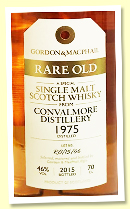 |
Convalmore 1975/2015 (46%, Gordon & MacPhail ‘Rare Old’, cask #R0/15/06, refill sherry hogshead, 299 bottles) 
Colour: gold. Nose: wooft! Pure heather honey, resinous fir wood, a coconut-drenched pina colada, mineral oils, wormwood, immense waxes and camphor vibes, verbena and wonderful notes of fennel, tarragon and honeycomb. Stunning nose! Mouth: this quality that I always adore that makes me think of very old mead, or some kind of crystallised or salted honey. It has this in spades, along with more deeply herbal and medicinal combinations that go towards very old yellow Chartreuse and cough syrups. Then waxiness and superbly fat textural elements that carry all these flavours brilliantly. Finish: good length, back on resins, fir wood, pinecones, tarragon, camphor and beeswax. Comments: one of these older highland styles that shows sublimely at this kind of age when just left to its own devices in simple, lighter touch wood.
SGP: 552 - 90 points. |
|
|
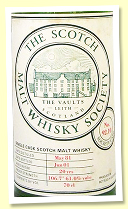 |
Lochside 20 yo 1981/2001 (61.0%, Scotch Malt Whisky Society 92.10 ‘Cod-liver oil and blackcurrants’) 
Colour: bright straw. Nose: very citrus and grass driven, with vivid notes of crushed nettles, finger limes, Viognier, putty, lemon barley water, grapefruit and also some clean cereal and mineral oil notes. Very pure and fresh, I love it. With water: wonderfully on green herbs, citrus fruits and mineral qualities. Aged Riesling and Chenin Blanc, clay, putty, petrol and buttered white toast. Extremely precise and beautifully tense. Mouth: rather tight, punchy and petrolic, with lots of clay, aniseed, fresh muddled herbs, lime peel, wormwood and a drying waxiness. Tough but brilliant distillate. With water: really explodes with water! Geraniums, vase water, lime curd, jasmine flower, exotic fruit teas, limestone, waxed canvass, bergamot oil and a few drops of very old Benedictine. A truly specific and unusual profile that’s all to do with power, precision and this very wonderful green / fresh / citric / mineral quartet. I’m sure Serge would call this a ‘wine drinkers malt’. Finish: long, tense, nervous, quivering green acidity, white flowers, underripe gooseberry, petrol and tarragon. Comments: sitting somewhere between St Magdalene and… Lochside, of course. Amazing and unique distillate that could keep you, a pipette and a bottle of water, entertained for hours.
SGP: 661 - 91 points. |
|
|
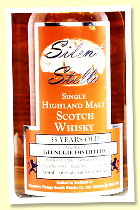 |
Glenugie 33 yo 1966/2000 (48.1%, Signatory Vintage ‘Silent Stills’, cask #5081, 148 bottles) 
Colour: straw. Nose: shoe polish and mashed exotic fruits. Then pink grapefruit more specifically, a tiny hint of seawater and huge notes of lime and waxed citrus rinds. Extremely zesty, fresh and with these sharp and grassy notes of rapeseed oil and parsley. Typically exuberant and bewilderingly fruity old Glenugie. Mouth: a little closed up front on arrival, some funny notes of mocha coffee, cocoa, ales and breads. Then more exotic hoppy IPA vibes, and then a huge burst of tropical fruits of all type and style. Total and utterly deadly fruit juice at this strength. Rather simple in some ways, but I find that rather an asset here. Finish: medium in length but gloriously fruity, more shoe polish fatness, leathery notes, seawater and grapefruit again and these nicely waxy and gentle peppery notes. Comments: I would say that this would probably have been totally sublime if bottled a few years younger, feels like it was caught just as it was coming over the hill. That said, the sheer fruitiness of it and especially that tropical flashbomb on the swallow were giddiness-inducing and hugely fun. Another totally wonderful old Glenugie.
SGP: 751 - 91 points. |
|
|
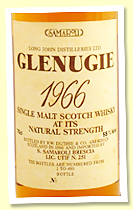 |
Glenugie 1966/1986 (55%, Samaroli, 480 bottles) 
I’ve tried this one a few times before and always been impressed. However, Serge recorded notes for this way back in 2006 and it only clocked in at WF88 at that time, while plenty other folk have scored it much higher over the years. Let’s revisit again, with an open mind… Colour: gold. Nose: clear shared DNA with the Signatory bottling, but this one also immediately reminds me of Lochside with this very particular grassy and exotic combination. Exotic fruit pulp, passionfruit, herbal and fruit teas and subtle impressions of verbena and a mix of mechanical and cooking oils. I still feel that this is an excellent whisky with a highly distinctive profile. With water: becomes greener, leaner and grassier. Some green pepper, snapped twigs, moss, nettle, lime zest and very sharp, almost trebly exotic notes. Mouth: cooking oils, waxes, marmalade, metal polish, suet, flower honey and mead. That’s just to begin, it has impressive complexity, but it seems to develop away from the exotic fruitiness on the nose, more towards these cooking oil qualities, preserved citrus fruits, beers, waxes, clay, mineral oil, some tiger balm - very big whisky, but maybe the issue is it can be a little all over the place, lacking coherence perhaps? With water: some of the same grassy, green, sharpness of the nose comes through - gooseberry, lime, nettle etc - but it’s still a rather punchy, peppery, waxy and slightly austere profile. Finish: long, drying, well-chiselled brittle waxy notes, along with further impressions of old-style ales, breads, camphor and slightly medicinal herbal qualities. Comments: I suspect this is one of those whiskies which will always divide opinion. Tasted in certain lights I can easily see how it might dazzle, but tasted in at my desk on a quiet Fife afternoon, I find myself more in alignment with Serge back in 2006. It’s very impressive and captivating whisky, but I feel it perhaps lacks a bit of direction, and in that sense isn’t technically brilliant. There are certainly many other Samaroli bottlings of similar pedigree which show much more immediate and unequivocal beauty. Now, it’s entirely possible I would have tried it in the past and given a different verdict depending on the conditions… so, as always, please take my silly score with a pinch of salt.
SGP: 662 - 89 points. |
|
|
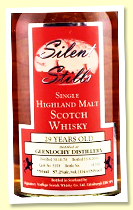 |
Glenlochy 29 yo 1970/2000 (57.2%, Signatory Vintage ‘Silent Stills’, cask #3359, 248 bottles) 
A rare bottling for the USA. Colour: pale gold. Nose: the more Glenlochys I try, the more I feel it is something like the Clynelish of the West. This wonderful waxiness and distillate-derived fatness that feels also mechanical, slightly animalistic and highly mineral is like Clynelish speaking with a west highland accent to my palate. There’s also lovely fresh hints of grass and crushed green herbs along with a little punchy olive oil. With water: more clay, sheep wool oils and an impression of porridge laced with sea salt and honey. What I love most is the potency of the distillate which is still almost entirely what this whisky is about even at 29 years old. Mouth: big, chewy, superbly waxy, mineral and oily with a lot of yellow flowers, salted honey, crushed flower stems, vase water, clay, ointments, putty and tea tree oil. Treads that lovely line between mechanical and rustic with this mineral and waxy profile that brings in medical stuff, garages and toolbox vibes along with it. With water: retains this wonderful fatness and richness in the mouth. Honey mixed with olive oil with a tang of seawater and filtered through sheep wool. I’d also add more clay, ink and shoe polish into the mix. Finish: good length, with a little white stone and exotic fruit hints in the aftertaste, more medicine and cooking oils too. Comments: it’s also a whisky that makes me think of older Oban bottlings too, in the sense that this is powerful, hugely characterful but rather challenging west highland style malt whisky - a profile that’s extremely scarce these days. But we shouldn’t get too hung up on comparing this to other distilleries. Glenlochy is, or sadly rather was, Glenlochy, and it remains one of the distilleries whose loss was a greater shame than most in my view. Another wonderful example.
SGP: 472 - 92 points. |
|
|
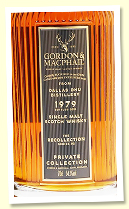 |
Dallas Dhu 43 yo 1979/2023 (54.1%, Gordon & MacPhail ‘Private Collection’, cask #1404, refill hogshead, 155 bottles) 
I think we can still count Dallas Dhu as ‘closed’ for the time being, despite chatter about its imminent return. Colour: deep gold. Nose: we’re in familiar ‘honeyed’ territory of these old, older style, malts. Only here it is even more narrowly focused and precisely on beeswax, pine wood, linseed furniture oil, burlap sack, cough syrup and tiny inflections of desiccated coconut, gorse flower and mead. It’s beautiful, but gives the impression of being ever so slightly closed. With water: gets nicely sappy, mentholated and displays some lovely, softer notes of sandalwood, beeswax, camphor and even touches of very old Demerara rum. Mouth: one of those whiskies where you feel it has been captured on something of a knife edge, the wood is very present, but it’s full of superb resinous and spice qualities that add to the depth of flavour and don’t just come through as dryness and tannin. Lots of exotic and various herbal teas and infusions, dried mint, eucalyptus, more cough medicine vibes, specifically darjeeling tea now, and then some nice floral touches with pressed wildflowers and dusty pollens. With water: becomes a little too astringent and woody now I would say. The flavours remain pretty marvellous, but it develops towards a very peppery and slightly tannic profile with more teaish vibes and a touch of bitterness. Finish: long, back on honeys, camphor, strong herbal teas, waxes and warming peppery notes. Comments: wonderful old whisky in many senses, and very entertaining development from nose to palate if you have a little water to hand. However, it’s hard not to feel it would have been even more luminous if bottled a few years earlier.
SGP: 561 - 89 points. |
|
|
Let’s wrap up with a sort of ‘additional sequel’ to last week’s Glen Mhor post and try two Glen Albyn. It’s a malt about which I have similar feelings to Glen Mhor, in that it could be great, but rather monolithic, austere and tough - especially from the 1970s up until closure. With that in mind, we’ll go forwards in time… |
|
|
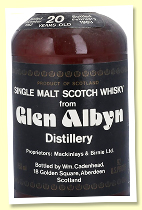 |
Glen Albyn 20 yo 1962/1983 (92 US proof, Cadenhead Dumpy) 
Colour: pale amber. Nose: Ha! It’s what I can only describe as a 50/50 combination of ‘old Cadenhead Dumpy’ profile + pre-war malt whisky profile. Which means, lots of metal polish, huge waxes, soot, camphor and oiliness from the former, plus an almost herbal liqueurish, medicinal, earthy and dry, soft peaty quality from the latter. Add into the mix some very old-style sherry influence with this pure, perfectly drying, earthy and ruggedly salty aroma that recalls excellent VORS Oloroso. So far, I really like it. Mouth: it seems to alight exactly where it should be: late 50s/early 60s, old style highland malt from a sherry cask! Big, fat, oily-textured malt whisky full of waxes, animalistic edges, mineral oils, bone marrow, huge umami and savoury notes of mushroom powder, bouillon, Maggi and soy sauce, then more metal polish, dried herbs, aniseed, curious old ointments and deeply earthy and mulchy notes that incorporate some very fine tobaccos and humidor vibes. This restless saltiness remains very present. Finish: long, warming, peppery, with these deeper earthy notes brining dryness, more herbal liqueur qualities, more stock, marrow, camphor and wax. Comments: totally old school! A whisky to demonstrate to anyone still in doubt, that the broad characters of Scottish malt whisky have changed rather a lot over the past fifty or so years. Plenty of these old Cadenhead Dumpies are of variable quality these days, and certainly there are some old Cadenhead Glen Albyns of similar pedigree which are a bit all over the place, but this one is fits very well into that category of rugged, powerful, deeply characterful old style highland malt whisky that I unashamedly adore.
SGP: 473 - 91 points. |
|
|
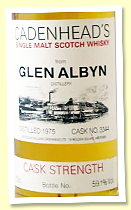 |
Glen Albyn 1975 (59.1%, Cadenhead for Oddbins, cask #3344, bottled early 1990s) 
A famous series that was done for Oddbins (where I worked around 2007) and which contained some out of this work selections, but also a few rather less likely picks as well. Colour: pale gold. Nose: ruggedly salty and fat distillate-driven old school whisky. Loads of tertiary waxy and mineral notes, hugely petrolic, with notes of peppery watercress, fennel seed, honey roast parsnips, crushed aspirin and metal polish. It has this monolithic and austere side, but it also has something ‘extra’ that just elevates everything in terms of depth and power. Very impressive so far! With water: superbly peppery and oily, more camphor, sunflower oil, further notes of watercress, suet, bouillon and mineral qualities like coal and beach pebbles. Mouth: oh wow, farmyard, coal dust, lightly peated Brora (can that be a tasting note?), wood ashes, sheep wool, bike chain oil, hessian toolbox rags - one of those whiskies that seems to only make you think of flavours and things you shouldn’t really put in your mouth. Very sooty, very oily, very fatty, very peppery and very waxy. There’s also a persistent salinity about it which brings freshness and power. With water: bone dry, stunningly peppery, oily and fat, with a brittle, sharp waxiness running throughout. Another one of these old school malts that recalls top class, aged, dry white wines. Finish: very long, still on peppery and dry waxy qualities, but adding in some traces of dried out, crystallised old honey, ink, shoe polish, more sooty vibes and more sheep wool. Comments: a total beast! Really in keeping with the theme of this old white label series, which seems to have been ‘massive fucking whiskies’. Anyway, this clearly demonstrates that old Invernesian ‘toughness’ while also being a terrific old school highlander at the same time. Now, you probably need to set aside about two hours to properly grapple with one dram of this…
SGP: 372 - 91 points. |
|
|
Big thanks to Phil T and to KC! |
|
|
|
|
| |
|
|
|
|
|
|

